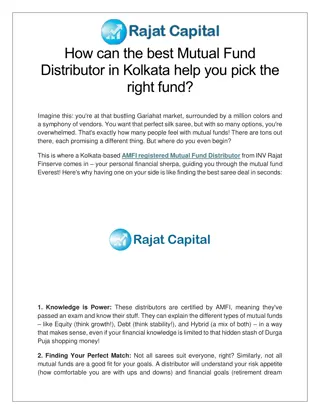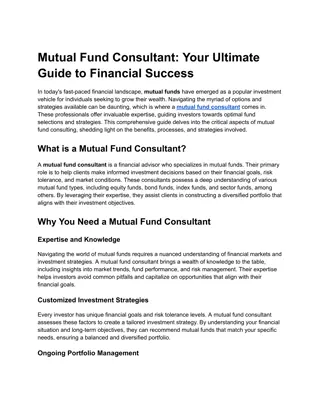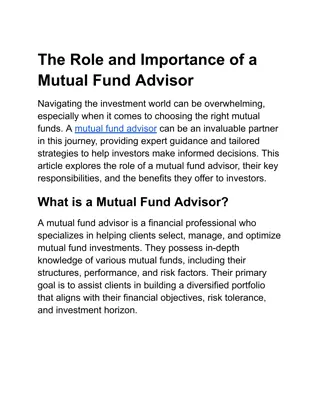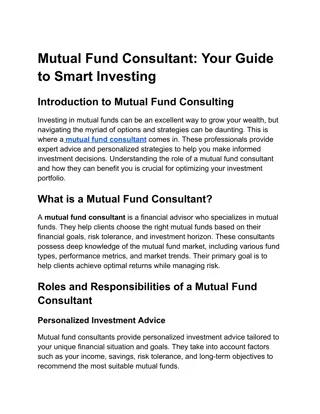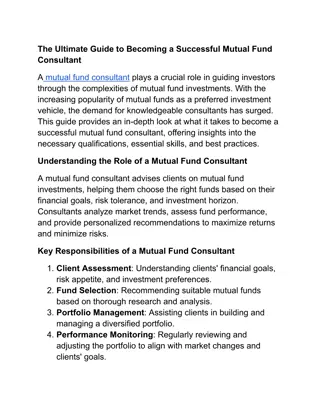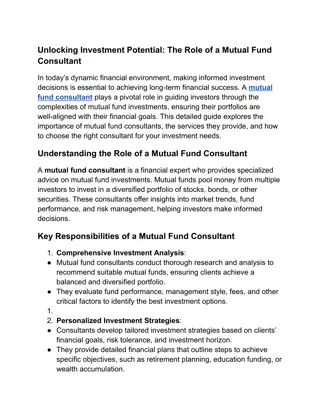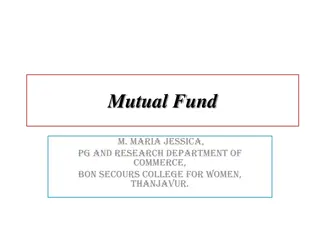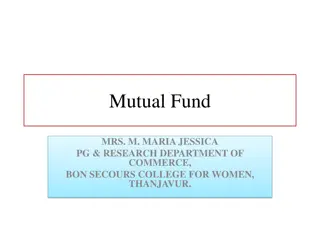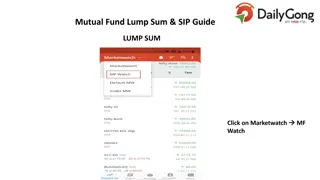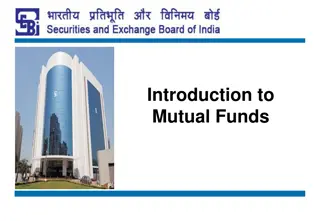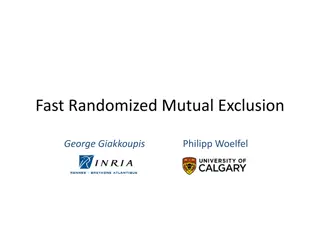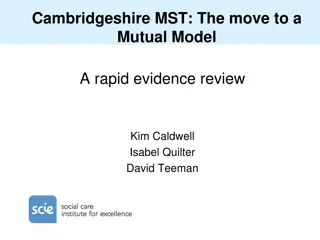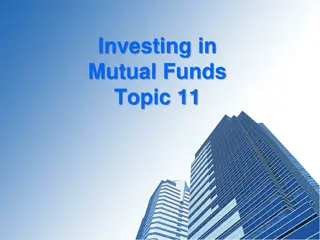Mutual Fund
Learn about mutual funds, a pool of savings from many investors for collective investment in capital market instruments. Discover the benefits, features, and objectives of mutual funds.
Download Presentation

Please find below an Image/Link to download the presentation.
The content on the website is provided AS IS for your information and personal use only. It may not be sold, licensed, or shared on other websites without obtaining consent from the author.If you encounter any issues during the download, it is possible that the publisher has removed the file from their server.
You are allowed to download the files provided on this website for personal or commercial use, subject to the condition that they are used lawfully. All files are the property of their respective owners.
The content on the website is provided AS IS for your information and personal use only. It may not be sold, licensed, or shared on other websites without obtaining consent from the author.
E N D
Presentation Transcript
What Is Mutual Fund ? A mutual fund is a trust that pools the savings of a A mutual fund is a trust that pools the savings of a number of investors who share a common financial number of investors who share a common financial goal goal The money thus collected is then invested in capital The money thus collected is then invested in capital market instruments such as shared bonds debentures & market instruments such as shared bonds debentures & other securities other securities The income earned through these investments and the The income earned through these investments and the capital appreciation released are shared by its unit capital appreciation released are shared by its unit holders in appreciation released are shared by its unit holders in appreciation released are shared by its unit holders in proportion to the number of units own by holders in proportion to the number of units own by them them
Origin Of Mutual Fund The mutual fund industry in India started in The mutual fund industry in India started in 1963 the formation of Unit Trust of India, at the initiative of the formation of Unit Trust of India, at the initiative of the Government of India and Reserve Bank of India. the Government of India and Reserve Bank of India. The growth was slow but it accelerated from the year The growth was slow but it accelerated from the year 1897 1897 when non when non - - UTI players entered in the Industry UTI players entered in the Industry 1963 with with
FEATURES OF MUTUAL FUND Economic development Economic development Fund mobilization Fund mobilization Investment opportunity Investment opportunity Low cost Low cost Maximum return Maximum return- -minimum risk Professional Management Professional Management Regulation Regulation Switching schemes Switching schemes Tax benefits Tax benefits minimum risk
OBJECTIVE OF MUTUAL FUND To mobilize savings of people To mobilize savings of people Offers a convenient way for the small investors to enter the capital & Offers a convenient way for the small investors to enter the capital & the money market the money market To tap domestic savings and channelise them for profitable To tap domestic savings and channelise them for profitable investment . If the value of mutual fund goes up the return on them investment . If the value of mutual fund goes up the return on them increases & vice versa increases & vice versa To enable the investors to share the prosperity the capital market. To enable the investors to share the prosperity the capital market. The net income earned on the funds, along with capital appreciation The net income earned on the funds, along with capital appreciation of the investment,is shared amongst the unit holders in proportion to of the investment,is shared amongst the unit holders in proportion to the units owned by them the units owned by them
Mutual fund is therefore an indirect vehicle for the Mutual fund is therefore an indirect vehicle for the investor investing in capital markets investor investing in capital markets To act as agents for growth and stability of the To act as agents for growth and stability of the capital market capital market To attract investments from the risk averters To attract investments from the risk averters To facilitate the orderly development of the capital To facilitate the orderly development of the capital market market
KEY PLAYERS OF MUTUAL FUND Mutual fund is formed by a trust body. The business is set up by the sponsor, the money invested by the asset management and the operations monitored by the trustee. The diagram explains the operations of Mutual funds
Unit holder :- A person/ entity holding an undivided share in the assets of a mutual fund scheme Mutual fund :- Mutual Fund established in the form of a trust to raise monies through the sale of Units to public or a section of public under one or more schemes for investing in securities including money market instruments or Gold or Gold related instruments or Real Estate Assets
The market intermediaries are:- Custodian:- A custodian is responsible for the safekeeping of the securities of the Mutual Fund. They manage the investment account of the Mutual Fund, ensure the delivery and transfer of the securities. They also collect and track the dividends & interests received on the Mutual Fund investment. Registrar & Transfer Agent ( RTA) :-RTAs are responsible for maintaining the records of the unit holders and serve as Investor Service Centers at various locations. They process the investor transactions of purchase/redemption and manage funds relating to such transaction. They manage updating of information in investor accounts, called folios.All RTAs are required to be registered with SEBI as such.
Depository :- Under the depositories act 1996 ,a depository is body corporate who carries out the transfer of units to the unit holder in dematerialized form and maintains records thereof Distribution Agent : Today's financial institutions sell a broad range of financial products, including Mutual Funds MF are now primarily available from six distribution channels:- full- service broker, discount brokers , insurance agents , financial planners,banks and directly from the mutual fund company.
NAV CALCULATION & PRICING OF MUTUAL FUND
OPEN ENDED MUTUAL FUNDS Meaning:- Open ended fund is a collective investment scheme that can issue and redeem shares at any time. Features The investors are free to buy & sell units .There is no time limit These are not trade in stock exchanges Units can be sold at any time The main motive income generation say dividend The prices are linked to the net asset value because units are not listed on the stock exchange
CLOSE ENDED FUNDS Meaning :-The size of funds and it's duration are fixed in advance.Once the subscription reaches the predetermined level, the entry of investors will be closed. After the expiry of the fixed period, the entire corpus is disinvested & the proceeds are distributed to the unit holders in proportion to their holding. Features :- The period & the target amount of the funds are fixed beforehand Once the period is over & or the target is reached, the subscription will be closed ( i.e investors cannot purchase any more units) The main objective is capital appreciation At the time of redemption, the entire investment is liquidated and the proceeds are distributed among the unit holders Units are listed & traded in stock exchanges Generally the prices of units are quoted at a discount of up to 40 %below their net asset value.
Open ended & Close ended differentiated as under
INTERVAl & EQUITY FUNDS Interval funds:-Interval funds provide the perfect blend of both closed-end funds and open-ended funds. Similar to closed-end funds, you cannot buy/sell the units frequently in interval funds. These funds might be listed on a stock exchange like other closed-end funds. Fund houses may allow redemption during specified periods at prevailing Net Asset Value (NAV). Equity funds :-Equity funds are known to generate better returns than term deposits or debt-based funds. There is an amount of risk associated with these funds since their performance depends on various market conditions.
DEBT FUNDS Debt funds :Debt funds invest in securities which generate fixed income like treasury bills, corporate bonds, commercial papers, government securities, and many other money market instruments. All these instruments have a pre-decided maturity date and interest rate that the buyer can earn on maturity hence the name fixed-income securities. The returns are usually not affected by fluctuations in the market. Therefore, debt securities are considered to be low- risk investment options.
MONEY MARKET& HYBRID FUND Money market funds:-Money Market Funds are short-term debt funds. They invest in various money market instruments and endeavor to offer good returns over a period of up to one year while maintaining high levels of liquidity. The average maturity of a Money Market Fund is one year. Balanced or Hybrid funds :-As the name suggests, hybrid funds are a combination of equity and debt investments which are designed to meet the investment objective of the scheme. Each hybrid fund has a different combination of equity and debt targeted at different types of investors.
GROWTH FUND Growth fund:- A growth fund is a mutual fund or exchange-traded fund (ETF) that includes companies primed for revenue or earnings growth at a pace that is faster than that of either industry peers or the market overall. Growth funds are separated by market capitalization into small-, mid- and large-cap, with large-cap the biggest class of funds, with a nearly 10% market share. Most growth funds are high-risk, high-reward and are therefore best suited to market participants with a long- term investment horizon and a healthy risk tolerance.
INCOME FUND Income funds :-Income funds are mutual funds or ETFs that prioritize current income, often in the form of interest or dividend paying investments. Income funds may invest in bonds or other fixed- income securities as well as preferred shares and dividend stocks. Income funds are often considered lower risk than funds that prioritize capital gains.
Liquid funds Liquid funds :- Liquid funds are debt funds that invest in short-term fixed-interest generating money market instruments. These can be treasury bills, commercial paper, and so on, which mature within 91 days. These are low-risk havens which offer higher returns than a savings bank account. Liquid funds try to emulate the liquidity aspect of a savings bank account. These funds don t have exit loads. It gives you the freedom to withdraw funds as per your convenience.
CAPITAL PROTECTION FUND Capital Protection Funds:-A mutual fund, categorized under closed-hybrid funds, oriented towards protecting your capital from any market risk with balanced exposure to both equities and debt is known as Capital Protection Fund. Their portfolio is largely inclined towards debt securities. It invests the majority of its assets in highly rated bonds, T-Bills, certificate of deposits and other fixed-income financial vehicles that give assured returns at maturity
FIXED MATURITY FUNDS Fixed Maturity Funds :- Fixed maturity plans are close-ended debt funds, meaning investments can be made only during the time of a new fund offer. It comes with a fixed maturity period and invests across debt instruments such as high rated securities and corporate bonds. These are designed to ensure that investors get a predictable rate of return, and at the same time tax-efficient, against the instability of interest rates.
PENSION & LOW RISK FUNDS ON & LOW RISK FUNDS Pension funds:- Pension funds are investment pools that pay for workers' retirements. Funds are paid for by either employees, employers, or both. Corporations and all levels of government provide pensions Low risk Funds :-Mutual Funds with minimal risk factors involved are called Low-risk Mutual Funds. These funds come with higher returns assurance as they predominantly invest in Government Bonds of infrastructure, real estate, etc. The risk-free or low risk investment portfolio of these funds ensure that either they match or stay ahead of inflation. As these funds have a major portion of total assets allocated into debt instruments, the investment horizon is relatively low.
MEDIUM RISK , HIGH RISK & SECTOR FUNDS Medium risk - medium risk investors might be those starting to near retirement, somebody who has less time to invest or wants to take a smaller amount of risk. A medium-risk investor would generally diversify their investments, i.e. shares, bonds, property and cash, while still trying to maximise returns. High risk - typically a high risk investor would be someone who has very good knowledge of investments, who wants to achieve the biggest returns possible, or somebody with a high income or significant assets who can afford to take more risk. Sector fund :- A sector fund is a type of Mutual Fund that invests in securities of specific sectors of the economy, such as banking, telecom, FMCG, pharmaceutical, Information Technology (IT), and infrastructure. In other words, sector funds narrow down your invested wealth only to the specific industry or sector. . Read more at: https://www.fincash.com/l/best-sector-mutual-funds
INDEX FUNDS Index Funds:An index funds seeks to track the performance of benchmark market index like the BSE Sensex or S&P CNX Nifty. The funds maintains the portfolio of all the securities in the same proportionas stated in the benchmark index. Index scheme is a widely popular concept in the west. IDBI Index Fund launched the first Index Fund in 1999
CONTRA & DIVIDEND YIELD FUNDS Contra fund :- A contra fund invests in those out of favour companies that have unrecognised value.It is ideally suitable for investors who want to invest in a fund that has the potential to perform in all types of market environment as it blends together both growth & value opportunities A dividend yield fund :- Invests in shares of companies having high dividend yields. Dividend yield is defined as per share divided by the share's market price. Most of these funds invests in stocks of companies having a dividend yield higher than the dividend yield of a particular index i.e Sensex or Nifty. Dividend yielding stocks are generally less volatile than growth stocks.
FLEXI / MULTI CAP & FUND OF FUNDS Flexi cap / Multi cap Fund :-These are by definition, diversified funds. The only difference is that unlike a normal diversification fund, the offer document of a multi cap/ Flexi cap fund generally spells out the limits for minimum and maximum exposure to each of the market caps Fund of funds :- These are the funds that invest in other mutual funds and returns depend on the performance of the target fund. These funds can also be referred as multi manager funds. These funds are considered relatively safe because the funds that investors invest in actually hold other funds under thereby adjusting for risk from any one fund.
EMERGING & INTERNATIONAL MARKET FUNDS Emerging Market Funds :- These are funds where investments are made in developing countries that show good prospects for the future. They do come with higher risks as a result of the dynamic political and economic situations prevailingin the country International Funds:- A mutual funds located in India to Raise money in India for investing globally.These are also known as foreign funds and offer investments in companies located in other parts of the world. The only companies that won't be invested will be those located in the investor's own country
GLOBAL & REAL ESTATE FUNDS Global Mutual Funds:-Global mutual funds invest in companies which are spread around the globe. They allow investors to invest in international markets. Real estate funds:-Real Estate Funds are sector funds that invest in securities of companies from the real estate sector. In other words, these funds provide the capital to the real estate company to develop a property. If the sector grows, then the fund makes good returns. A real estate fund might invest in real estate companies or REITs (Real Estate Investment Trusts) based on the investment objective of the fund among other factors.
COMMODITY FOCUSED STOCK & MARKET NEUTRAL FUNDS Commodity focused stock funds:-A commodity fund is a fund that is invested in the trade of a particular commodity, thereby allowing investors an opportunity to earn returns based on the performance of these commodities in the market. These funds specialise invest in a specific product. Any fluctuation in the price of these commodities will have a direct bearing on the returns earned on transacting. Market neutral Funds :- These funds are called market neutral is that because they don't invest in the market directly.They invest in treasury bills, ETFs and securities and try to target a fixed and steady growth.
INVERSE/ ASSET ALLOCATION FUND Inverse or Leveraged Funds :-These are the funds that operate unlike traditional mutual funds .The earnings from these funds happen when the market fall and when markets do well these funds tend to go into loss. Generally these are meant for those people who are willing to incur massive losses but at the same time can provide huge returns as well,as a result of the higher risk they carry. Asset Allocation Fund :-An asset allocation fund is a fund that provides investors with a diversified portfolio of investments across various asset classes. The asset allocation of the fund can be fixed or variable among a mix of asset classes, meaning that it may be held to fixed percentages of asset classes or allowed to go overweight on some depending on market conditions
GILT FUNDS Gilt Funds :-Gilt funds only invest in government securities ranging from medium to long-term horizons. So, these funds satisfy the security needs of investors. They are not the same as bond funds because the latter may allocate a part of the assets in corporate bonds, which can be risky. Gilt funds invest in low-risk debt instruments such as the government securities, which ensures the preservation of capital along with moderate returns.
EXCHANGED TRADED FUNDS ETFs share characteristic features of both shares and mutual funds. They are generally traded in the stock market in the form of shares produced via creation blocks. ETF funds are listed on all major stock exchanges and can be bought and sold as per requirement during the equity trading time.
ADVANTAGES OF MUTUAL FUNDS Professional Management Diversification Convenient Administration Higher Returns Low Cost Of Management Liquidity Transparency Highly Regulated Other benefits:- The Investors can also switch from one scheme to another without load . Mutual funds provide regular withdrawal & systematic investment plans according to the need of the investors
DRAWBACKS OF INVESTING IN MUTUAL FUNDS No Guarantee of Return Diversification Selection of proper funds Cost Factor/ High management fee Unethical practices Others:- a. Mutual funds systems do not maintain the kind of transparency they should maintain. b. Many MF scheme are at times, subject lock in period, therefore,deny the market drawn benefits c. At times, the investments are subject to different kind of hidden costs d. Redressal of grievances,ifany,is not easy
MUTUAL FUNDS RISKS Market risks Investment risks Business risks Political risk Scheme risks
SEBI REGULATIONS FOR MF (1) Formation: Certain structural changes have also been made in the mutual fund industry, as part of which mutual funds are required to set up asset management companies with fifty percent independent directors, separate board of trustee companies, consisting of a minimum fifty percent of independent trustees and to appoint independent custodians. (2) Registration: In January 1993, SEBI prescribed registration of mutual funds taking into account track record of a sponsor, integrity in business transactions and financial soundness while granting permission.
(3) Documents: The offer documents of schemes launched by mutual funds and the scheme particulars are required to be vetted by SEBI. A standard format for mutual fund prospectuses is being formulated. (4) Code of advertisement:Mutual funds have been required to adhere to a code of advertisement. (5) Assurance on returns:SEBI has introduced a change in the Securities Control and Regulations Act governing the mutual funds. Now the mutual funds were prevented from giving any assurance on the land of returns they would be providing. However, under pressure from the mutual funds, SEBI revised the guidelines allowing assurances on return subject to certain conditions.
(6) Minimum corpus:The current SEBI guidelines on mutual funds prescribe a minimum start-up corpus of Rs.50 crore for a open- ended scheme, and Rs.20 crore corpus for closed-ended scheme, failing which application money has to be refunded. (7) Institutionalisation:The efforts of SEBI have, in the last few years, been to institutionalise the market by introducing proportionate allotment and increasing the minimum deposit amount to Rs.5000 etc. These efforts are to channel the investment of individual investors into the mutual funds. (8) Investment of funds mobilised:In November 1992, SEBI increased the time limit from six months to nine months within which the mutual funds have to invest resources raised from the latest tax saving schemes. The guideline was issued to protect the mutual funds from the disadvantage of investing funds in the bullish market at very high prices and suffering from poor NAV thereafter.
(9) Investment in money market :SEBI guidelines say that mutual funds can invest a maximum of 25 per cent of resources mobilised into money-market instruments in the first six months after closing the funds and a maximum of 15 per cent of the corpus after six months to meet short term liquidity requirements. (10) Valuation of investment:The transparent and well understood declaration or Net Asset Values (NAVs) of mutual fund schemes is an important issue in providing investors with information as to the performance of the fund. SEBI has warned some mutual funds earlier of unhealthy market (11) Inspection:SEBI inspect mutual funds every year. A full SEBI inspection of all the 27 mutual funds was proposed to be done by the March 1996 to streamline their operations and protect the investor s interests. Mutual funds are monitored and inspected by SEBI to ensure compliance with the regulations.
(12) Underwriting: In July 1994, SEBI permitted mutual funds to take up underwriting of primary issues as a part of their investment activity. This step may assist the mutual funds in diversifying their business. (13) Conduct:In September 1994, it was clarified by SEBI that mutual funds shall not offer buy back schemes or assured returns to corporate investors. The Regulations governing Mutual Funds and Portfolio Managers ensure transparency in their functioning. (14) Voting rights: In September 1993, mutual funds were allowed to exercise their voting rights. Department of Company Affairs has reportedly granted mutual funds the right to vote as full-fledged shareholders in companies where they have equity investments.








